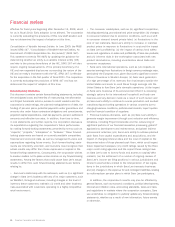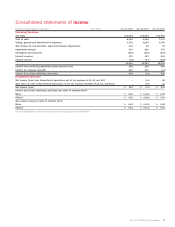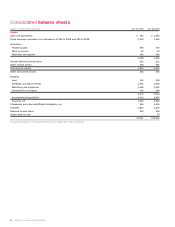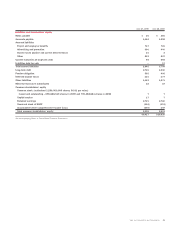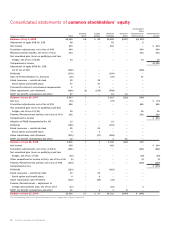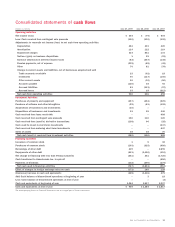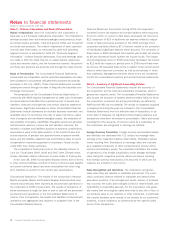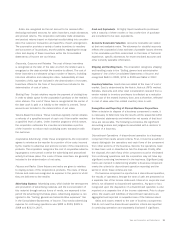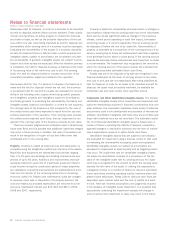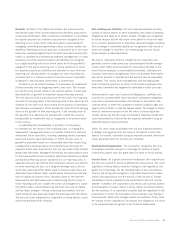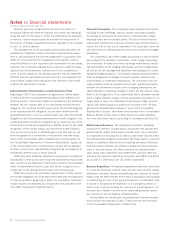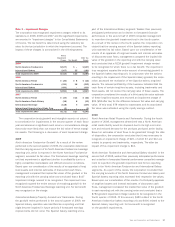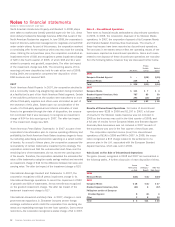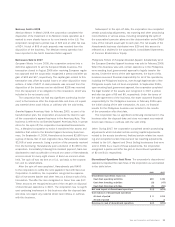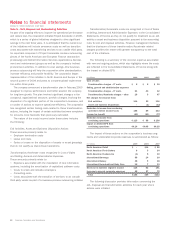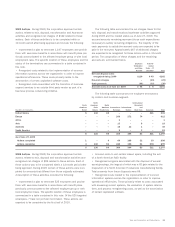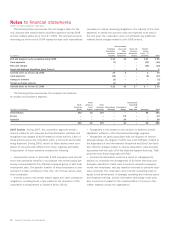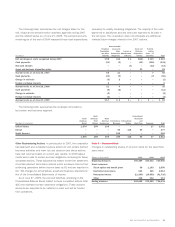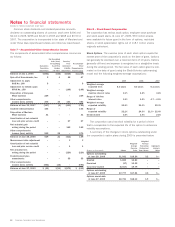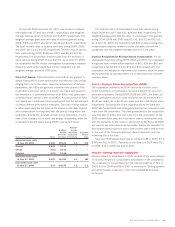Sara Lee 2009 Annual Report Download - page 58
Download and view the complete annual report
Please find page 58 of the 2009 Sara Lee annual report below. You can navigate through the pages in the report by either clicking on the pages listed below, or by using the keyword search tool below to find specific information within the annual report.Notes to financial statements
Dollars in millions except per share data
Deferred taxes are recognized for the future tax effects of
temporary differences between financial and income tax reporting
using tax rates for the years in which the differences are expected
to reverse. Federal income taxes are provided on that portion of
the income of foreign subsidiaries that are expected to be remitted
to the U.S. and be taxable.
The management of the corporation periodically estimates the
probable tax obligations of the corporation using historical experi-
ence in tax jurisdictions and informed judgments in accordance with
GAAP. For a tax benefit to be recognized, a tax position must be
more-likely-than-not to be sustained upon examination by the taxing
authority. The corporation adjusts these reserves in light of chang-
ing facts and circumstances; however, due to the complexity of
some of these situations, the ultimate payment may be materially
different from the estimated recorded amounts. Any adjustment to
a tax reserve impacts the corporation’s tax expense in the period
in which the adjustment is made.
Defined Benefit, Postretirement and Life-Insurance Plans
Beginning in 2007, the corporation recognizes the funded status
of defined pension and postretirement plans in the statement of
financial position. The funded status is measured as the difference
between the fair market value of the plan assets and the benefit
obligation. For a defined benefit pension plan, the benefit obligation
is the projected benefit obligation; for any other defined benefit
postretirement plan, such as a retiree health care plan, the benefit
obligation is the accumulated postretirement benefit obligation. Any
overfunded status should be recognized as an asset and any under-
funded status should be recognized as a liability. As part of the initial
recognition of the funded status, any transitional asset/(liability),
prior service cost (credit) or actuarial (gain)/loss that had not yet
been recognized as a component of net periodic cost was recog-
nized in the accumulated other comprehensive income section of
the Consolidated Statements of Common Stockholders’ Equity, net
of tax. Accumulated other comprehensive income will be adjusted
as these amounts are subsequently recognized as a component of
net periodic benefit costs in future periods.
GAAP prescribes additional disclosure requirements including the
classification of the current and noncurrent components of plan liabil-
ities, as well as the disclosure of amounts included in Accumulated
Other Comprehensive Income (Loss) that will be recognized as a
component of net periodic benefit cost in the following year.
GAAP also requires the consistent measurement of plan assets
and benefit obligations as of the date of the fiscal year end statement
of financial position. Beginning in 2009, the corporation measures
its plan assets and liabilities as of fiscal year end pursuant to the
new GAAP measurement date provisions.
Financial Instruments The corporation uses financial instruments,
including forward exchange, options, futures and swap contracts,
to manage its exposures to movements in interest rates, foreign
exchange rates and commodity prices. The use of these financial
instruments modifies the exposure of these risks with the intent to
reduce the risk or cost to the corporation. The corporation does not
use derivatives for trading purposes and is not a party to leveraged
derivatives.
The corporation uses either hedge accounting or mark-to-market
accounting for its derivative instruments. Under hedge accounting,
the corporation formally documents its hedge relationships, includ-
ing identification of the hedging instruments and the hedged items,
as well as its risk management objectives and strategies for under-
taking the hedge transaction. This process includes linking derivatives
that are designated as hedges of specific assets, liabilities, firm
commitments or forecasted transactions. The corporation also for-
mally assesses, both at inception and at least quarterly thereafter,
whether the derivatives that are used in hedging transactions are
highly effective in offsetting changes in either the fair value or cash
flows of the hedged item. If it is determined that a derivative ceases
to be a highly effective hedge, or if the anticipated transaction is no
longer likely to occur, the corporation discontinues hedge account-
ing and any deferred gains or losses are recorded in the “Selling,
general and administrative expenses” line in the Consolidated
Statements of Income. Derivatives are recorded in the Consolidated
Balance Sheets at fair value in other assets and other liabilities.
For more information about accounting for derivatives see Note 18.
Self-Insurance Reserves The corporation purchases third-party
insurance for workers’ compensation, automobile and product and
general liability claims that exceed a certain level. The corporation
is responsible for the payment of claims under these insured limits.
The undiscounted obligation associated with these claims is accrued
based on estimates obtained from consulting actuaries. Historical
loss development factors are utilized to project the future develop-
ment of incurred losses, and these amounts are adjusted based
upon actual claim experience and settlements. Accrued reserves,
excluding any amounts covered by insurance, were $201 and $202
as of June 27, 2009 and June 28, 2008, respectively.
Business Acquisitions All business acquisitions have been accounted
for under the purchase method. Cash, the fair value of other assets
distributed, securities issued unconditionally and amounts of consid-
eration that are determinable at the date of acquisition are included
in determining the cost of an acquired business. Consideration that
is issued or issuable at the expiration of a contingency period, or
that is held in escrow pending the outcome of a contingency, is not
recorded as a liability or shown as an outstanding security unless
the outcome of the contingency is determinable.
Substantially all consideration associated with business acquisi-
tions involves the payment of cash. These amounts are disclosed
in the Consolidated Statements of Cash Flows.
56 Sara Lee Corporation and Subsidiaries


